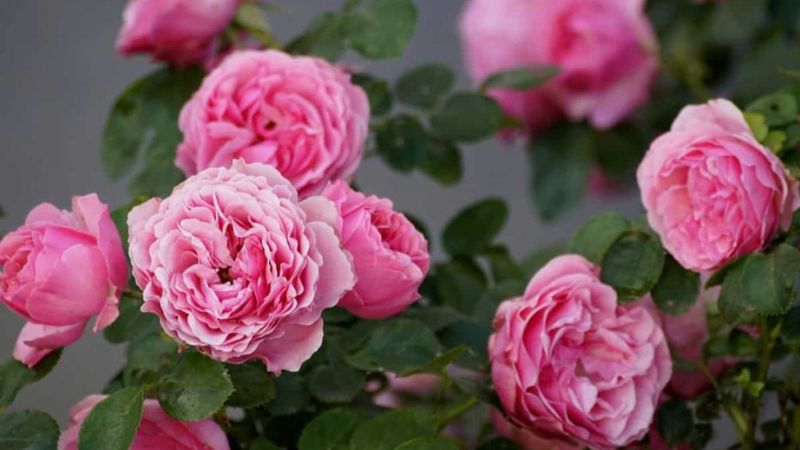Roses are a timeless addition to any garden, admired for their beauty and fragrance. However, not all plants make suitable neighbors for roses. Some can hinder their growth, attract pests, or compete for resources, leading to unhealthy rose bushes. To ensure your roses thrive, it’s essential to avoid planting certain species nearby. Here are eight plants you should never grow next to roses.
1. Garlic

Garlic is often touted for its pest-repelling properties, but it can be detrimental when planted too close to roses. The strong scent of garlic can overshadow the delicate fragrance of roses, detracting from their appeal. Additionally, garlic releases sulfur compounds into the soil, which can alter the pH balance and nutrient availability. This change can affect the growth and health of roses, making them more susceptible to diseases and nutrient deficiencies. While garlic is excellent for keeping aphids and other pests at bay, it’s best to plant it in a separate part of your garden away from your cherished roses.
2. Black Walnut
Black walnut trees produce a chemical called juglone, which is toxic to many plants, including roses. Juglone is released from the roots, leaves, and nuts of the black walnut tree, and it can persist in the soil for years, inhibiting the growth of nearby plants. Roses are particularly sensitive to juglone, and exposure can lead to stunted growth, wilting, and even death. If you have a black walnut tree in your garden, make sure to plant your roses at least 50 feet away to avoid any harmful effects.
3. Mint
Mint is a vigorous grower with a tendency to spread quickly, often invading nearby plantings. Its aggressive root system can compete with roses for nutrients and water, depriving them of essential resources. Additionally, mint’s sprawling habit can overshadow rose bushes, reducing air circulation and increasing the risk of fungal diseases. Controlling mint can be challenging, and once it takes hold, it can be difficult to eradicate. To protect your roses, it’s best to grow mint in containers or a designated area far from your rose beds.
4. Potatoes

Potatoes are heavy feeders that can compete with roses for nutrients in the soil. Both plants require significant amounts of nitrogen, potassium, and phosphorus for optimal growth, and when planted together, they can deplete the soil’s nutrient reserves. Additionally, potatoes and roses share some common pests and diseases, such as aphids and blight, which can easily spread between them. To ensure healthy growth and minimize pest and disease issues, keep potatoes and roses in separate areas of your garden.
5. Sunflowers
Sunflowers are tall, sun-loving plants that can cast shade on your rose bushes, depriving them of the sunlight they need to thrive. Roses require at least six hours of direct sunlight each day for optimal growth and flowering. Additionally, sunflowers have deep root systems that can compete with roses for water and nutrients. The dense foliage of sunflowers can also reduce air circulation around rose bushes, increasing the risk of fungal diseases. To maintain a healthy and vibrant rose garden, plant sunflowers in a separate area where they won’t overshadow your roses.
6. Fennel
Fennel is a plant that produces allelopathic chemicals, which can inhibit the growth of nearby plants, including roses. These chemicals are released through the roots and can persist in the soil, affecting the growth and health of sensitive plants. Fennel’s tall, feathery foliage can also overshadow rose bushes, reducing their access to sunlight. Additionally, fennel attracts certain pests, such as aphids and caterpillars, which can also attack roses. To avoid these issues, it’s best to plant fennel well away from your rose beds.
7. Brassicas
Brassicas, such as broccoli, cabbage, and cauliflower, are known to attract a variety of pests, including aphids, cabbage worms, and flea beetles. These pests can quickly spread to nearby roses, causing damage and stress. Additionally, brassicas are heavy feeders that require substantial nutrients from the soil, which can lead to competition with roses for essential resources. To prevent pest infestations and ensure your roses have access to the nutrients they need, plant brassicas in a separate part of your garden.
8. Trees with Aggressive Roots

Trees with aggressive root systems, such as maple, willow, and elm, can compete with roses for water and nutrients. These trees have extensive root networks that can invade rose beds, depriving them of essential resources. Additionally, the dense canopy of these trees can cast shade on rose bushes, reducing their access to sunlight and air circulation. This can lead to poor growth and an increased risk of fungal diseases. To protect your roses, avoid planting them near trees with aggressive roots, and ensure they receive plenty of sunlight and adequate space for healthy growth.
In conclusion, choosing the right plant companions is crucial for maintaining a healthy and vibrant rose garden. By avoiding these eight plants, you can ensure your roses receive the nutrients, sunlight, and air circulation they need to thrive. Careful planning and thoughtful planting can help create a beautiful and harmonious garden where your roses can flourish.




